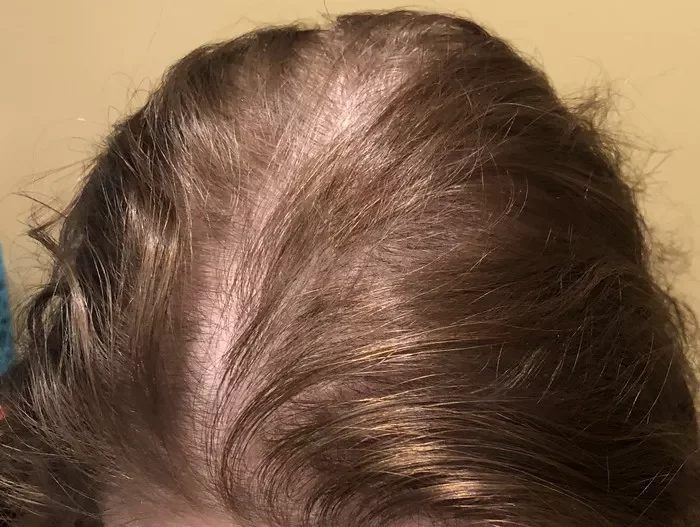Androgenic alopecia, commonly known as male or female pattern baldness, is a prevalent form of hair loss affecting millions worldwide. Despite its widespread occurrence, the precise cause of androgenic alopecia remains a subject of ongoing research and debate within the medical community. This article aims to delve into the intricate mechanisms underlying this condition, shedding light on its multifactorial nature and exploring the interplay of genetic, hormonal, and environmental factors that contribute to its onset and progression.
The Genetic Blueprint: Unraveling the Role of Genetics
Genetics plays a pivotal role in the development of androgenic alopecia, with hereditary factors accounting for a significant proportion of its occurrence. Research indicates that individuals with a family history of baldness are more predisposed to experiencing hair loss themselves. This familial predisposition is attributed to the inheritance of specific genes that influence hair follicle sensitivity to androgens, particularly dihydrotestosterone (DHT), a potent male sex hormone.
One of the key genetic determinants implicated in androgenic alopecia is the androgen receptor gene, located on the X chromosome. Variations in this gene can result in heightened androgen sensitivity within hair follicles, leading to their gradual miniaturization and eventual cessation of hair growth. Additionally, genes encoding enzymes involved in androgen metabolism, such as 5-alpha-reductase, play a crucial role in modulating DHT levels within the scalp, further influencing hair follicle function.
Hormonal Havoc: The Influence of Androgens
Androgens, particularly testosterone and its metabolite DHT, exert a profound influence on hair follicle activity and are central to the pathogenesis of androgenic alopecia. DHT, in particular, is known for its potent effects on hair follicles, binding to androgen receptors located within the scalp and initiating a cascade of molecular events that disrupt the hair growth cycle.
In individuals predisposed to androgenic alopecia, DHT interacts with susceptible hair follicles, triggering a process known as follicular miniaturization. This phenomenon involves the progressive shrinking of hair follicles over time, resulting in the production of finer, shorter hairs that are increasingly prone to shedding. Ultimately, affected follicles may enter a state of dormancy, ceasing to produce visible hair altogether.
The precise mechanisms by which DHT exerts its deleterious effects on hair follicles are complex and multifaceted. DHT binding to androgen receptors within the dermal papilla cells, which play a crucial role in hair follicle nourishment and growth, disrupts signaling pathways involved in follicle regeneration and maintenance. Moreover, DHT-mediated alterations in gene expression within the follicular epithelium contribute to structural changes that impede normal hair growth, paving the way for baldness to ensue.
Environmental Influences: Navigating the Impact of Lifestyle and External Factors
While genetics and hormonal factors represent primary drivers of androgenic alopecia, environmental influences also play a contributory role in its etiology. Various lifestyle factors and external stressors have been implicated in exacerbating hair loss and accelerating the progression of balding in susceptible individuals.
Nutritional Deficiencies: Inadequate intake of essential nutrients vital for hair health, such as vitamins, minerals, and proteins, can compromise the integrity of hair follicles and exacerbate hair loss. Deficiencies in nutrients like iron, zinc, biotin, and vitamin D have been linked to impaired hair growth and increased susceptibility to alopecia.
Stress and Psychological Factors: Chronic stress, anxiety, and psychological distress can exert a profound toll on overall health and well-being, including hair health. Elevated levels of stress hormones such as cortisol may disrupt the hair growth cycle, leading to increased shedding and exacerbation of androgenic alopecia.
Environmental Toxins: Exposure to environmental pollutants, toxins, and certain medications can disrupt hormonal balance and adversely affect hair follicle function. Substances such as cigarette smoke, heavy metals, and endocrine-disrupting chemicals may contribute to hair loss by interfering with normal physiological processes within the scalp.
Hair Care Practices: Overzealous hair care practices, including frequent use of heat styling tools, harsh chemical treatments, and tight hairstyles, can damage hair follicles and exacerbate hair loss. Vigorous brushing, tight ponytails, and excessive tension on the hair shaft can lead to traction alopecia, a form of hair loss caused by mechanical stress on the scalp.
Medical Conditions and Medications: Certain underlying medical conditions, such as thyroid disorders, autoimmune diseases, and hormonal imbalances, can predispose individuals to hair loss, including androgenic alopecia. Additionally, medications used to treat these conditions, such as chemotherapy drugs, anticoagulants, and antidepressants, may have hair loss as a potential side effect.
The Intersection of Nature and Nurture: Integrating Genetic Predisposition with Environmental Triggers
While genetic predisposition sets the stage for the development of androgenic alopecia, environmental factors serve to modulate the expression of inherited traits and influence the course of the condition. The interplay between genetic susceptibility and environmental triggers underscores the complex nature of androgenic alopecia and highlights the importance of adopting a multifaceted approach to its management and prevention.
Conclusion
Androgenic alopecia represents a multifactorial condition characterized by a complex interplay of genetic, hormonal, and environmental factors. While genetic predisposition lays the groundwork for the development of baldness, hormonal imbalances, lifestyle choices, and external stressors contribute to its onset and progression. Understanding the intricate mechanisms underlying androgenic alopecia is crucial for devising targeted therapeutic strategies aimed at mitigating its impact and preserving hair health. By unraveling the root causes of this prevalent condition, researchers and healthcare professionals can pave the way for more effective interventions and improved outcomes for individuals affected by male and female pattern baldness.


